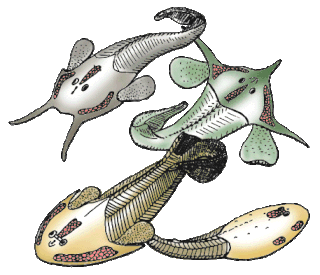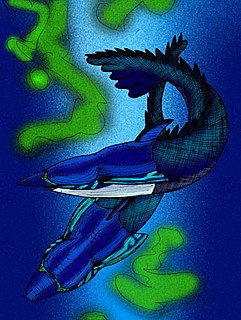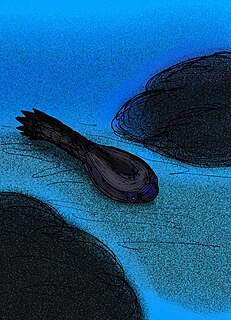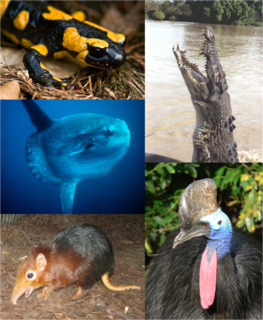The Devonian is a geologic period and system of the Paleozoic, spanning 60 million years from the end of the Silurian, 419.2 million years ago (Mya), to the beginning of the Carboniferous, 358.9 Mya. It is named after Devon, England, where rocks from this period were first studied.
The PaleozoicEra is the earliest of three geologic eras of the Phanerozoic Eon. It is the longest of the Phanerozoic eras, lasting from 541 to 251.902 million years ago, and is subdivided into six geologic periods : the Cambrian, Ordovician, Silurian, Devonian, Carboniferous, and Permian. The Paleozoic comes after the Neoproterozoic Era of the Proterozoic Eon and is followed by the Mesozoic Era.

Placodermi is a class of armoured prehistoric fish, known from fossils, which lived from the Silurian to the end of the Devonian period. Their head and thorax were covered by articulated armoured plates and the rest of the body was scaled or naked, depending on the species. Placoderms were among the first jawed fish; their jaws likely evolved from the first of their gill arches. Placoderms are paraphyletic, and consist of several distinct outgroups or sister taxa to all living jawed vertebrates, which originated among their ranks. This is illustrated by a 419-million-year-old fossil, Entelognathus, from China, which is the only known placoderm with a type of bony jaw like that found in modern bony fishes. This includes a dentary bone, which is found in humans and other tetrapods. A recent analysis shows placodermi to be likely monophyletic. The jaws in other placoderms were simplified and consisted of a single bone. Placoderms were also the first fish to develop pelvic fins, the precursor to hindlimbs in tetrapods, as well as true teeth. Paraphyletic groupings are problematic, as one can not talk precisely about their phylogenic relationships, their characteristic traits and literal extinction. 380-million-year-old fossils of three other genera, Incisoscutum, Materpiscis and Austroptyctodus, represent the oldest known examples of live birth.

Ostracoderms are the armored jawless fish of the Paleozoic. The term does not often appear in classifications today because it is paraphyletic or polyphyletic, and has no phylogenetic meaning. However, the term is still used as an informal way of loosely grouping together the armored jawless fishes.

The Late Devonian extinction was one of five major extinction events in the history of life on Earth. A major extinction, the Kellwasser event, occurred at the boundary that marks the beginning of the last phase of the Devonian period, the Famennian faunal stage, about 376–360 million years ago. Overall, 19% of all families and 50% of all genera became extinct. A second, distinct mass extinction, the Hangenberg event, closed the Devonian period.

Arthrodira is an order of extinct armoured, jawed fishes of the class Placodermi that flourished in the Devonian period before their sudden extinction, surviving for about 50 million years and penetrating most marine ecological niches.
The Hangenberg event is a bioevent that occurred at the end of the Famennian stage associated with the Late Devonian extinction ; it was an anoxic event marked by a black shale. It has been proposed that this was related to a rapid sea-level fall due to the last phase of the Devonian Southern Hemisphere glaciation. It has also been suggested that it was linked to an increase in terrestrial plant cover, leading to increased nutrient supply in rivers. This may have led to eutrophication of semi-restricted epicontinental seas and could have stimulated algal blooms.

Ctenaspis is an extinct genus of heterostracan cyathaspid agnathans from the early Devonian of Canada.

Furcacauda is a genus of thelodontid agnathan from the Lower Devonian of Canada, and is the type genus of the order Furcacaudiformes. Furcacaudiform thelodontids were deep water jawless vertebrates with symmetrical fork and lobed-finned tails and scales smaller than typical loganellid and nikoliviid thelodonti scales. Furcacaudiform thelodonts are noted as having a laterally compressed body, large anterior eyes, slightly posterior, lateral, and vertical to a small mouth, and a condensed curved row of branchial openings (gills) directly posterior to the eyes. Many but not all had laterally paired fins. Wilson and Caldwell also note the presence of a caudal peduncle and a long caudal fin made of two large lobes, one dorsal and one ventral separated by 8 to 14 smaller intermediate lobes, giving the appearance of a striated half-moon shaped tail resembling the tail of a heterostracan. A large square cavity within the gut connecting a small intestine to an anal opening lead many to believe that it is this genus that exhibits the first vertebrate stomach. According to Wilson and Caldwell their discovery, based on sediment infillings of fossils of the Furcacauda heintze, gives credence to the evolutionary development of stomach before jaws.
Lechriaspis is an extinct genus of poraspid heterostracan agnathan known from the Early Devonian of northern Utah, western United States.
Poraspis is an extinct genus of heterostracan. Fossils are found in Late Silurian and Early Devonian marine strata of Norway, Canada and the United States.
Ariaspis is an extinct genus of cyathaspidiform heterostracan agnathan. Fossils are found in marine strata of Canada and Europe from the late Silurian period until its extinction during the Early Devonian. A new species, A. arctata, was described by David K. Elliott and Sandra Swift in 2010.

The evolution of fish began about 530 million years ago during the Cambrian explosion. It was during this time that the early chordates developed the skull and the vertebral column, leading to the first craniates and vertebrates. The first fish lineages belong to the Agnatha, or jawless fish. Early examples include Haikouichthys. During the late Cambrian, eel-like jawless fish called the conodonts, and small mostly armoured fish known as ostracoderms, first appeared. Most jawless fish are now extinct; but the extant lampreys may approximate ancient pre-jawed fish. Lampreys belong to the Cyclostomata, which includes the extant hagfish, and this group may have split early on from other agnathans.

Panamintaspis snowi is an extinct species of pteraspidid heterostracan agnathan which existed during the early Middle Devonian period of Death Valley, California. Fossils are found in Late Emsian-aged marine strata of the Lost Burro Formation. P. snowi strongly resembles Pteraspis, though while it was originally described as a member of the same family, Pteraspididae, a recent phylogenetic reassessment of the order Pteraspidiformes places P. snowi within the paraphyletic family "Protopeteraspidae," as the sister taxon of the suborder Pteraspidoidei.

Psammmosteida also called as Psammosteoidei is a suborder of pteraspidid heterostracan agnathans. The psammosteids had broad, flattened bodies, suggesting a predominantly benthic habit. The earliest unequivocal psammosteid is Drepanaspis of Early Devonian Germany, which is either included in the family Psammosteidae, or placed within its own family, Drepanaspididae. If the late Silurian/Early Devonian Weigeltaspis is a psammosteid, as opposed to being a traquairaspid, then that genus, instead, would be the oldest psammosteid. However, its placement within Heterostraci remains a matter of debate. Other notable psammosteids include Psammosteus, and Obruchevia, two genera of enormous species with dorsal shields around one meter in diameter. The Psammosteids were the only heterostracans to survive to the end of the Devonian, where they finally perish during the Hangenberg event.

Pteraspidiformes is an extinct order of heterostracan agnathan vertebrates known from extensive fossil remains primarily from Early Devonian strata of Europe and North America, and from Upper Silurian Canada.

Cyathaspidiformes is an extinct order of heterostracan vertebrates known from extensive fossil remains primarily from Silurian to Early Devonian strata of Europe, and North America, and from Early Devonian marine strata of Siberia.

Anglaspis is an extinct genus of cyathaspidiform heterostracan agnathan. Fossils are found in marine strata of Europe, from the late Silurian period until genus' extinction during the Early Devonian. As with other cyathaspidiforms, individuals of Anglaspis had dorsal and ventral plates covering the forebody, gill pouches, and nasal openings that lay on the roof of the oral cavity.
Anchipteraspididae is an extinct family of heterostracan vertebrates restricted to Late Silurian and Early Devonian strata of Arctic Canada.















